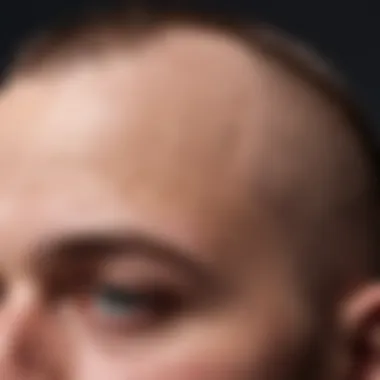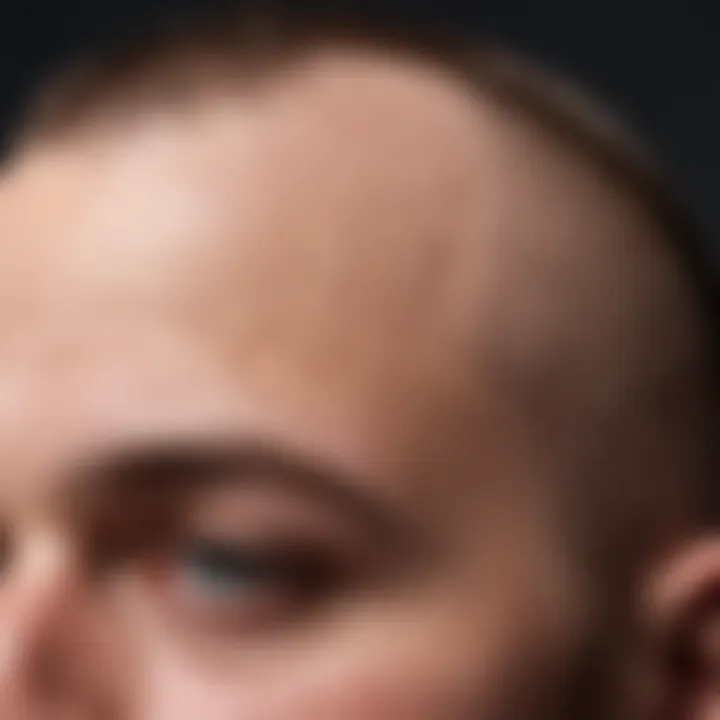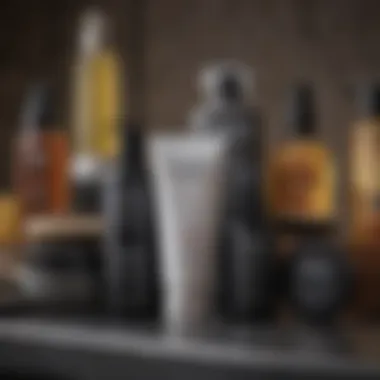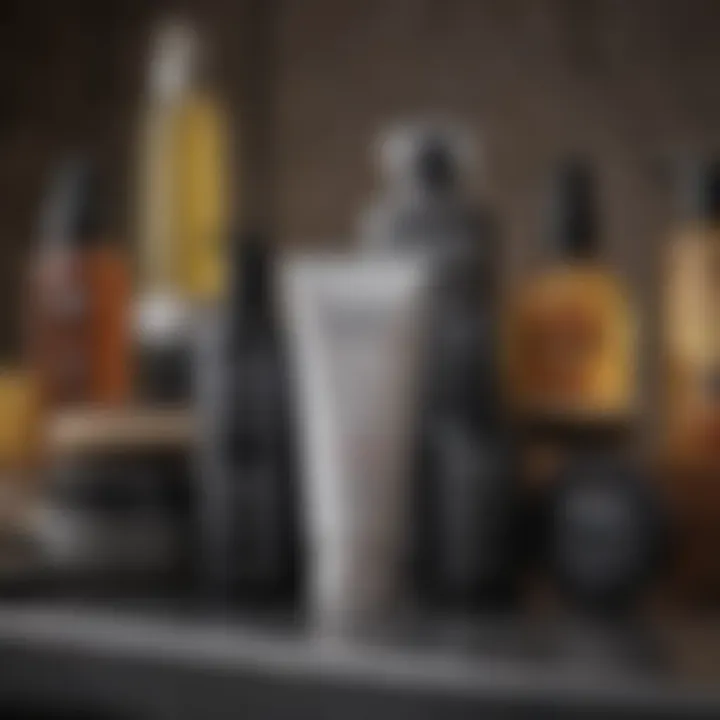Understanding Bumps on the Head After Shaving: Causes and Solutions


Intro
Bumps on the head after shaving can be quite troubling. Many individuals experience this issue, yet few understand the underlying causes. The skin can react in various ways, depending on technique, products used, and individual sensitivities. Knowing these details can be helpful.
In this exploration, we aim to clarify why bumps develop and how simple adjustments can lead to better outcomes. Understanding the root of the problem is essential for anyone wishing to enhance their shaving routine. We will also discuss effective solutions to alleviate discomfort and prevent future occurrences. With the right knowledge, readers can take control of their grooming practices.
Intro to Post-Shaving Bumps
Shaving is a routine for many men, often performed weekly or daily. Yet, post-shaving bumps can often ruin the carefully curated look. Understanding these bumps is essential for improvement in grooming habits. This section delves into why these bumps occur and their significance in the broader context of grooming for men.
When one shaves, the skin undergoes a series of reactions. Recognizing these reactions can help in addressing the bumps that may arise afterward. It is important for men to be aware of how their skin reacts to various techniques and products. By grasping the underlying causes of bumps, one can take informed steps toward better shaving outcomes.
A proactive approach to this issue not only helps improve skin health but also enhances overall grooming practices. Investing time in understanding post-shaving bumps leads to improved self-presentation and personal confidence.
Overview of the Issue
Bumps after shaving can manifest in various forms, from small red spots to larger inflamed patches. These bumps often signal an ongoing issue that deserves attention. It is crucial to understand that they are not merely a cosmetic concern but can represent underlying skin conditions like ingrown hairs or irritation.
Many factors contribute to these bumps. These include skin type, shaving technique, and the products used during the shaving process. Identifying the specific cause is the first step in finding effective solutions.
Significance for Men’s Grooming
Men’s grooming involves more than just a fresh shave; it encompasses the overall health and appearance of the skin. Shaving bumps can detract from an otherwise refined look. For men invested in their fashion and personal style, understanding how to prevent and treat these bumps is vital.
Shaving bumps can influence a man's willingness to maintain a clean-shaven appearance. There may be hesitation to shave if bumps lead to discomfort or visible skin issues. Hence, addressing the problem enhances not only the look but also the experience of shaving itself.
Moreover, selecting the right grooming products and honing better techniques can create a sustained improvement in skin condition, reinforcing the importance of this topic. The right knowledge leads to techniques that can help men navigate the challenges of grooming with confidence.
Causes of Bumps After Shaving
Understanding the causes of bumps after shaving is crucial for achieving a smooth and irritation-free experience. These bumps can result from a variety of factors that involve both skin and grooming products. Recognizing the specific reason behind the post-shave irritation allows individuals to take informed actions, improving their grooming routine over time. Furthermore, acknowledging these causes helps prevent discomfort, which is essential for men who prioritize their grooming and style.
Ingrown Hairs Explained
Ingrown hairs occur when a hair grows back into the skin instead of projecting through the surface. This can happen due to tight clothing, coarse hair, or improper shaving techniques. When hair curls back under the skin, it creates irritation and inflammation, leading to painful bumps.
To reduce the likelihood of ingrown hairs, consider the following strategies:
- Shave in the direction of hair growth to minimize irritation.
- Exfoliate regularly to remove dead skin cells that can trap hairs.
- Use a sharp razor and replace blades frequently to ensure a clean cut.
Sensitivity and Allergic Reactions
Some individuals may experience sensitivity or allergic reactions to shaving products. Ingredients in creams, gels, or aftershaves can trigger a response from the skin, leading to redness, bumps, and discomfort. Common allergens include fragrances, alcohol, and certain preservatives.
To handle this issue, it is effective to:
- Perform a patch test on a small area of skin before applying new products.
- Opt for hypoallergenic products specifically designed for sensitive skin.
- Identify and avoid specific allergens through careful observation of reactions after use.
Razor Burn: What You Need to Know
Razor burn is a common form of skin irritation caused by friction, improper technique, or dull blades. Symptoms often present as redness, itching, and small bumps on the skin. This condition happens more frequently among men who shave often or those who have coarse hair textures.
To minimize the risk of razor burn:
- Use a lubricant like shaving cream or gel to reduce friction.
- Shave with smooth, long strokes, avoiding pressure on the razor.
- Take your time and avoid rushing the shaving process; this can lead to mistakes and injuries.


Product Reactions: Shaving Creams and Gels
Not all shaving products are created equal, and some may not suit every skin type. Components in shaving creams and gels can lead to negative reactions, resulting in bumps. Those with oily or acne-prone skin may react more noticeably to certain formulations.
To select the right product:
- Read labels carefully to understand the ingredients.
- Choose non-comedogenic options that are less likely to clog pores.
- Test different brands to find those that work best for your skin type and sensitivities.
"The right grooming products can significantly reduce incidences of shaving bumps, leading to an overall better shaving experience."
By knowing these underlying causes, individuals can take necessary precautions to avoid bumps after shaving. Understanding one's skin and the impact of different products is key to enhancing personal grooming and style.
Identifying Your Skin Type
Identifying your skin type is a critical step in managing bumps on the head after shaving. Many men may not realize that their unique skin characteristics play a significant role in the outcome of their grooming routines. By understanding your skin type, you can tailor your shaving practices to minimize irritations and achieve better results. This section explores why knowing your skin type matters and how it influences your shaving strategy.
Importance of Knowing Your Skin
Understanding your skin is essential for several reasons. First, different skin types react uniquely to various products and techniques. For instance, those with oily skin may experience more frequent breakouts and require special attention to their grooming products. In contrast, individuals with dry skin may need more hydration to prevent flakiness and irritation after shaving.
Additionally, recognizing your skin type helps in selecting appropriate razors and creams. Sensitive skin needs products free from harsh chemicals, which can exacerbate irritation. By knowing your skin better, you can avoid common pitfalls that lead to bumps and discomfort after shaving. This awareness not only improves your overall grooming experience but also builds self-confidence.
How Skin Type Affects Shaving
Your skin type directly influences how shaving impacts your skin. For example, those with normal skin might find versatility in products and techniques, allowing for various options. However, sensitive skin is much more finicky and requires a delicate approach.
Here are some key factors to consider related to skin type:
- Oily Skin: This skin type is prone to acne and excess shine. Choosing non-comedogenic products can help prevent breakouts and reduce bumps.
- Dry Skin: A lack of moisture can lead to irritation after shaving. Using a rich pre-shave oil and a hydrating aftershave can alleviate dryness and promote skin health.
- Combination Skin: This skin type needs a balanced approach. It's important to address oily areas and dry patches differently to avoid discomfort.
- Sensitive Skin: Gentle shaving creams and proper techniques are essential. Always test new products to check for an adverse reaction.
Knowing your skin type transforms your approach to grooming, leading to effective prevention of post-shaving bumps.
Overall, identifying your skin type is not merely a preference but a necessity for effective shaving. Taking the time to understand your skin can save you from irritation and help maintain a healthier appearance.
Preventive Measures
Preventive measures are essential in managing bumps on the head after shaving. Understanding how to minimize this issue can greatly enhance your grooming routine. By implementing effective strategies, you can reduce discomfort and maintain healthier skin.
Choosing the Right Razor
Selecting an appropriate razor is a critical part of avoiding post-shaving bumps. Different types of razors exist. For example, safety razors, cartridge razors, and straight razors each have their unique benefits and downsides.
Cartridge razors often provide a convenient option. They are easier to use and come with multiple blades, which can give a smoother shave. However, this can lead to a higher risk of ingrown hairs. Safety razors require more skill but generally offer less irritation due to their single blade system, minimizing the chances of nicks and cuts.
When considering a razor, also pay attention to the blade sharpness. Dull blades tug at hair instead of cutting it cleanly, increasing the likelihood of bumps. A sharp blade glides through hair effortlessly, ensuring a precise shave.
Using the Right Shaving Technique
The technique you use while shaving significantly impacts skin health. First, always shave in the direction of hair growth. This reduces the risk of irritation and ingrown hairs. Pulling the skin taut while shaving can help achieve a closer cut without excessive pressure, which may lead to bumps.
Using short, gentle strokes will also minimize irritation. Avoid going over the same area repeatedly, as this increases friction and can cause razor burn and bumps. Additionally, do not rush the shaving process. Taking your time improves the overall quality of the shave and decreases the chance of skin issues.
Importance of Pre-Shave Preparation
Pre-shave preparation is often underestimated, yet it plays a crucial role in achieving a smooth shaving experience. Preparing the skin helps to soften hair and open pores. This can be achieved through warm water or a hot towel. Warm water hydrates hair, making it easier to cut.


Applying a quality pre-shave oil can also enhance your shave. Oils provide a protective barrier between the skin and the blade, which can help prevent irritation. Opt for products that are non-comedogenic to avoid blocking pores. Incorporating a good quality shaving cream or gel into your routine further assists in achieving a clean shave. Such products create lubrication, reducing friction.
Tip: Always rinse your razor frequently during shaving to remove accumulated hair and cream. This will keep the blade effective and reduce the risk of bumps.
Implementing these preventive measures sets a solid foundation for an improved shaving routine. Understanding the importance of each aspect can significantly decrease irritation and the likelihood of developing bumps.
Aftercare Solutions
After shaving, the significance of aftercare cannot be overstated. Proper aftercare is essential to mitigate discomfort and prevent the occurrence of bumps on the head. When the skin undergoes the trauma of shaving, it needs adequate support to recover. Ignoring this phase may result in prolonged irritation and a higher likelihood of ingrown hairs. Here, we will elaborate on some effective strategies that can help soothe the skin and promote healing after shaving.
Soothing Ointments and Creams
Using soothing ointments and creams is an effective way to manage post-shaving bumps. These products typically contain ingredients designed to calm irritation and provide relief. For instance, aloe vera gel is highly recommended due to its natural soothing properties. It hydrates the skin and reduces redness.
Another option is creams with hydrocortisone, which can help reduce inflammation associated with razor burn. Applying these products can significantly improve skin comfort and appearance. It’s crucial to apply them gently to avoid further irritation.
While selecting ointments, choose those free from heavy fragrances or alcohol-based substances. Such elements can exacerbate skin sensitivity. Instead, look for options labeled as sensitive-skin friendly.
"Effective aftercare can transform the shaving experience from frustrating to refreshing."
Hydration and Moisturizing Techniques
Proper hydration is a vital element of any skin care routine, especially after shaving. After shaving, the skin can lose moisture, leading to dryness and irritation. To address this, consider incorporating a moisturizing technique that suits your skin type.
Using a high-quality moisturizer post-shave promotes hydration and helps create a protective barrier. Using products that contain glycerin or hyaluronic acid can draw moisture into the skin, replenishing lost hydration effectively. Applying these elements immediately after shaving can yield beneficial results.
Additionally, a simple pre-shave routine including a warm shower or using a warm towel can prepare the skin, making it more receptive to moisturizers afterward. This method allows for better absorption, promoting a smoother feel.
When to Seek Professional Help
In some cases, the need for professional intervention may arise. If bumps persist despite following home care or if they are accompanied by severe pain, swelling, or pus, it is wise to consult a dermatologist. A specialist can provide tailored treatments, including prescription-strength ointments or other therapeutic solutions.
Awareness of when to seek help is essential for maintaining skin health. Regular monitoring of your skin post-shave can help identify issues early. If shaving becomes consistently troublesome, adjustments to your technique or products may also be necessary. A professional can assist in tailoring a personalized grooming strategy suited to your skin needs, enhancing your overall shaving experience.
Common Misconceptions About Shaving Bumps
Understanding the different misperceptions regarding bumps after shaving is crucial for a comprehensive approach to grooming. Many individuals, particularly men who prioritize appearance, may unknowingly perpetuate falsehoods that could affect their shaving experience. Recognizing these misconceptions can lead to better prevention and treatment strategies. It can empower men to make informed choices about their grooming routines, leading to healthier skin and improved self-image.
Myths vs. Reality
Many myths cloud the conversation about shaving bumps, creating confusion and sometimes leading to ineffective practices. One common myth suggests that only individuals with coarse or curly hair experience shaving bumps. However, anyone can develop these bumps, regardless of hair type. Skin sensitivity can play a significant role, and many people do not realize they are at risk based solely on their hair characteristics.
Another misconception is that using a dull razor won’t have significant repercussions. In reality, dull blades can increase the chances of irritation and ingrown hairs, which often manifest as bumps after shaving. A sharp blade cuts hair cleanly and reduces trauma to the skin, offering a smoother experience.
Some people believe that shaving against the grain is a quick fix for a smoother finish. While it may seem appealing, this method often exacerbates irritation and contributes to the formation of bumps. It’s important to shave with the grain to minimize discomfort and reduce the likelihood of ingrown hairs.
- Further misconceptions include:
- The belief that all shaving creams are identical.
- Assuming products labeled as "sensitive skin" will not cause irritation.
Overall, understanding these myths can improve one’s grooming routine. Separating fact from fiction enables individuals to tailor their techniques and product choices, ultimately reducing the occurrence of post-shaving bumps.
"Being informed about common myths can lead to more effective grooming practices, enhancing overall skin health."
In sum, separating myths from reality is essential in addressing bumps on the head after shaving. Acknowledging the truth about grooming and skin care promotes effective solutions for all individuals, regardless of hair type or shaving habits.


The Role of Grooming Products
Grooming products play a crucial role in shaping the overall shaving experience for men. They can significantly affect skin health and the condition of the hair being shaved. Understanding how these products impact the skin can lead to better grooming outcomes and minimize issues such as bumps on the head after shaving.
Finding Suitable Shaving Creams
Finding the right shaving cream is vital for ensuring a smooth shave without adverse effects. Not all shaving creams are created equal. Ingredients in these products can influence skin reactions. For instance, creams containing aloe vera or shea butter have moisturizing properties, which can help prevent dryness and irritation.
When selecting shaving cream, consider your skin type:
- Sensitive Skin: Look for options labeled hypoallergenic or fragrance-free.
- Oily Skin: Creams with a matte finish can help control excess oil.
- Dry Skin: A hydrating cream will be beneficial to keep skin nourished.
Tip: Always conduct a patch test with new products to check for allergic reactions. This step can help reduce the risk of bumps after shaving.
Evaluating Razors and Blades
The choice of razor and blade is equally important. Different razors offer varying levels of comfort and closeness. Using a dull blade often leads to more irritation and a higher chance of cuts, which can trigger skin disturbances such as bumps.
When evaluating razors, consider:
- Single vs. Multi-Blade: Single-blade razors can be gentler on the skin, while multi-blade options provide a closer shave but may cause more irritation.
- Safety Razors: These may be more suitable for those prone to razor burn or bumps.
- Quality of Blades: High-quality blades like those from Gillette or Schick are worth the investment for better results.
Regularly replace blades to ensure they are sharp and effective. A fresh blade minimizes the risk of bumps forming post-shave.
"The foundation of a good shave lies not just in skill, but also in the tools and products used."
By focusing on both shaving cream and razors, individuals can create a more effective and comfortable shaving routine, ultimately reducing the occurrence of post-shaving bumps on the head.
Lifestyle Factors Affecting Skin Health
A man's grooming routine can be significantly influenced by lifestyle choices. Understanding how these factors come into play is essential in addressing post-shaving bumps. This section will discuss some of the key elements – diet and stress management – and how they might contribute to skin health, thereby impacting shaving outcomes.
Diet and Its Impact on Skin
Diet plays a critical role in overall skin health. The skin needs essential nutrients to maintain its barrier function and recover after shaving. Nutrients such as vitamins A, C, and E, along with essential fatty acids, can enhance skin condition.
- Hydration: Staying hydrated is vital. Water helps to maintain skin elasticity and overall appearance. Aim for at least eight glasses of water daily to keep skin nourished.
- Omega-3 Fatty Acids: Found in salmon, walnuts, and flaxseeds, omega-3 fatty acids can reduce inflammation and support skin barrier health. A reduction in skin irritation may help in preventing post-shave bumps.
- Antioxidants: Foods rich in antioxidants, such as berries and leafy greens, combat oxidative stress which can lead to skin damage.
- Limit Sugar and Processed Foods: Sugary snacks and processed foods can lead to increased inflammation. This can exacerbate skin issues, including the likelihood of post-shaving bumps.
Adapting your diet can be a simple yet powerful strategy to fortify your skin's resilience against shaving-related problems. Making mindful choices about what you consume not only benefits skin but also overall well-being.
Stress Management Techniques
Stress is often overlooked when discussing skin health, yet its effects can be profound. When stressed, the body produces more cortisol, which can lead to increased oil production and exacerbate acne and irritation, including bumps from shaving. Here are some strategies to manage stress effectively:
- Regular Exercise: Physical activity can reduce stress levels. It promotes blood flow and delivers more oxygen to the skin, aiding in its recovery post-shave.
- Mindfulness and Meditation: Engaging in mindfulness practices can help calm the mind and body, reducing the production of stress hormones. Techniques like deep breathing or yoga can be effective.
- Adequate Sleep: Sleep is crucial for skin regeneration. Aim for 7-9 hours per night. Poor sleep can impact skin clarity and recovery.
- Healthy Social Interactions: Engage with supportive friends and family. Positive relationships can mitigate stress and improve mood, which indirectly benefits skin health.
Incorporating these stress management techniques into daily life can lead to better skin health, specifically allowing for smoother shaving experiences.
Taking care of one's skin is not just a physical endeavor; it extends beyond to encompass lifestyle choices, highlighting the interconnectedness of grooming and daily habits.
Finale: Navigating Shaving Challenges
Navigating the challenges associated with post-shaving bumps is vital for those who make grooming a priority. Understanding the various factors that contribute to these bumps can significantly improve the shaving experience. Knowledge about skin types, suitable products, and techniques can help mitigate discomfort.
Being proactive in preventing bumps can save time and frustration. The article covers multiple aspects of shaving that relate directly to these bumps. Recognizing issues like ingrown hairs or razor burn empowers individuals to address their specific concerns.
The key benefits of comprehending the relationship between shaving and skin health include enhanced overall appearance, reduced irritation, and an improved grooming routine. Each section of the article highlights important considerations:
- Choosing proper shaving products can decrease the likelihood of adverse reactions.
- Implementing effective shaving techniques ensures smoother results.
- Regularly assessing personal skin sensitivity can guide future grooming decisions.
"Knowledge is power, especially in personal grooming."
Those who are aware of their skin and shaving needs can manage and prevent bumps effectively. This raises overall satisfaction and confidence in one's grooming routine. Ultimately, the journey to a bump-free shave becomes less about trial and error and more about informed choices. A thoughtful approach leads to substantial improvement and self-assurance in personal style and grooming.















